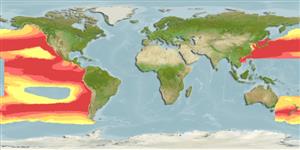Environment: milieu / climate zone / depth range / distribution range
Ecologia
marino batipelagico; distribuzione batimetrica 16 - 4938 m (Ref. 58302), usually 100 - 800 m (Ref. 58302). Deep-water
Eastern Pacific: Bering Sea (Ref. 6876), British Columbia (Canada) and Gulf of Panama. Reported from Chile (Ref. 9068). Indian Ocean (Ref. 26165).
Size / Peso / Age
Maturity: Lm ? range ? - ? cm
Max length : 3.0 cm TL maschio/sesso non determinato; (Ref. 26165)
Short description
Chiavi di identificazione | Morfologia | Morfometria
Spine dorsali (totale) : 0; Raggi dorsali molli (totale) : 13 - 14; Spine anali: 0; Raggi anali molli: 18 - 20; Vertebre: 30 - 32. Branchiostegal rays: 12-14.
Epipelagic and mesopelagic species, usually in upper 800 m depth with abundance maximum in upper 100 and 400-500 m (Ref. 35800). Bathypelagic (Ref. 58302). Oviparous, with planktonic eggs and larvae (Ref. 35800).
Life cycle and mating behavior
Maturities | Riproduzione | Spawnings | Egg(s) | Fecundities | Larve
McAllister, D.E., 1990. A list of the fishes of Canada. Syllogeus No. 64. Nat. Mus. Nat. Sci., Ottawa, Canada. 310 p. (Ref. 11980)
IUCN Red List Status (Ref. 130435)
Threat to humans
Harmless
Human uses
Strumenti
Special reports
Download XML
Fonti Internet
Estimates based on models
Preferred temperature (Ref.
123201): 0.9 - 20.9, mean 10.8 °C (based on 523 cells).
Phylogenetic diversity index (Ref.
82804): PD
50 = 0.5001 [Uniqueness, from 0.5 = low to 2.0 = high].
Bayesian length-weight: a=0.00389 (0.00171 - 0.00885), b=2.99 (2.79 - 3.19), in cm total length, based on LWR estimates for this (Sub)family-body shape (Ref.
93245).
Trophic level (Ref.
69278): 3.0 ±0.00 se; based on food items.
Resilienza (Ref.
120179): Alto, tempo minimo di raddoppiamento della popolazione meno di 15 mesi (Preliminary K or Fecundity.).
Fishing Vulnerability (Ref.
59153): Low vulnerability (10 of 100).
